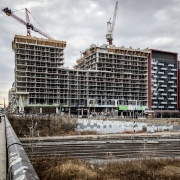Home buying activity hit a record high in the Toronto region last month as 10,970 properties changed hands.
February’s sales total represented a 52.5 percent increase over the same period last year, according to data published today by the Toronto Regional Real Estate Board (TRREB).
While buyer interest in suburban single-family homes has dominated headlines for months, the city’s condo market is climbing its way back into the spotlight. Continuing a trend established in December, condo sales jumped 64 percent last month with strong increases recorded in both the suburban 905 area and the urban 416.
The region’s condo market — especially units in Toronto’s downtown core — have been a notable weak spot in an otherwise robust housing picture. Despite the significant sales growth, condo prices continued their streak of annual declines in February, down 3.7 percent on the regional level and 6.4 percent in the city-proper. That said, TRREB’s Chief Market Analyst Jason Mercer sees potential for condo prices to begin posting gains again this year.
“[I]f we continue to see growth in condo sales outstrip growth in new condo listings in Toronto, renewed price growth in this market segment is a distinct possibility in the second half of the year,” said Mercer.
The balance between new listings and sales that Mercer is referring to was strongly tilted toward listings for much of 2020’s second half as many condo investors sought to offload their units while other condo owners took advantage of record-low interest rates to move-up to a larger property.
The balance has been shifting in recent months and, in February, condo sales were up 64 percent, outpacing new condo listings which grew by 42.6 percent annually. This trend will need to continue for condo prices to start increasing again, but things are moving in the right direction.
For the region’s housing market as a whole, TRREB President Lisa Patel is anticipating more supply-driven challenges this year as demand is already exceptionally strong moving into the typically busy spring homebuying season. Patel says that population growth is expected to pick up again as Canada’s vaccination campaign ramps up, so this could exacerbate the problem further.
TRREB’s Home Price Index rose nearly 15 percent annually in February while the average selling price of a Toronto region home was up a similar amount to $1,045,488. Buyer confidence and low borrowing costs have led to fierce competition in the single-family home market, where price growth has been concentrated.
“In the absence of a marked uptick in inventory, the current relationship between demand and supply supports continued double-digit average home price growth this year,” said Mercer.
It’s also worth noting that February 2020 was the last month of that year in which homebuying activity remained mostly unaffected by the looming pandemic. By the second half of March 2020, home sales began to collapse as the market froze in the face of accelerating virus transmission and widespread lockdowns. Expect some huge annual spikes in TRREB’s sales activity data during the months ahead when 2021’s booming market is compared to 2020’s lockdown-curtailed market.








 Maziar Moini, Broker of Record - Home Leader Realty Inc.
300 Richmond St. W., #300, Toronto, ON M5V-1X2
Maziar Moini, Broker of Record - Home Leader Realty Inc.
300 Richmond St. W., #300, Toronto, ON M5V-1X2


